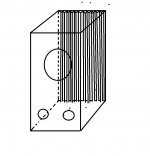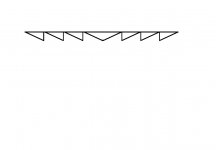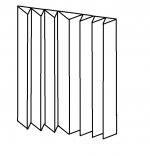Not a very interesting enclosure. Poorly tuned reflex box. Unless the vent sar eheaviy stuffed.
dave
I'm aware of that, but I have a question in relation to the formation of standing waves.
To sustain a standing wave requires a continuous input of energy at one exact frequency - a situation that can be maintained by the use of a signal generator.
When it comes to music signals, the input of energy at any one exact frequency tends to be transitory and non-continuous in nature.
To what extent can standing waves in enclosures be sustained by music signals which continually change in frequency?
I think harmonics can also excite eigenmodes, widening the initial conditions in which standing waves can develop.
I'm not sure who to believe, without evidence. How about guitar string, pluck it with a finger and the standing waves decay pretty long time, fundamental and harmonics. The pluck doesn't have any certain frequency, or maybe it has all the frequencies? Strings don't even have to be plucked, the string vibrates sympathetically as well. Put the guitar close to a loudspeaker, or a kick drum, piano, whatever, and hear the strings ring.
Mute/damp with the neck hand and all the standing waves are killed. Or just leave some of the harmonics with strategic muting. Food for thought, peace
Mute/damp with the neck hand and all the standing waves are killed. Or just leave some of the harmonics with strategic muting. Food for thought, peace
Last edited:
In addition, the amplitude which the pluck imparts to each of the individual harmonic modes of vibration of the string depends on where the string is plucked.
An eigenmode is a "normal mode in an oscillating system, being one in which all parts of the sysem are oscillating at the same frequency".I think harmonics can also excite eigenmodes, widening the initial conditions in which standing waves can develop.
Normal mode - Wikipedia
The Tacoma Narrows Bridge collapse would be a good example of an eigenmode: Tacoma Narrows Bridge Collapse "Gallopin' Gertie" - YouTubeWhen relating to music, normal modes of vibrating instruments (strings, air pipes, drums, etc.) are called "harmonics" or "overtones".
Bye and thanks for the answers.
I waited some time to respond to see if there was any other intervention.
I am forced to discard the golden ratio because it would result in too large an envelope. since the diameter of the woofer measures 38 cm I get a width of at least 40 cm and consequently a depth of 64 cm.
so I have to fold over a width of 40 cm and a depth of 50 cm with a difference of 10 cm per side.
In your opinion, rather than making the sloping walls, it could be a valid alternative to make the internal rear surface as per the attached images?.
I waited some time to respond to see if there was any other intervention.
I am forced to discard the golden ratio because it would result in too large an envelope. since the diameter of the woofer measures 38 cm I get a width of at least 40 cm and consequently a depth of 64 cm.
so I have to fold over a width of 40 cm and a depth of 50 cm with a difference of 10 cm per side.
In your opinion, rather than making the sloping walls, it could be a valid alternative to make the internal rear surface as per the attached images?.
Attachments
Forget that back wall,
better to use something more effective like Basotect pyramids.
Also add bracing ! Lots of bracing !
Front panel should be double panel or more.
better to use something more effective like Basotect pyramids.
Also add bracing ! Lots of bracing !
Front panel should be double panel or more.
danny_66, basotect as well as any other stuff that fits inside the enclosure mainly affect the higher frequencies. One should consider what is the passband of the speaker employing the enclosure for optimal strategy. If it is a sub, you can leave the box empty if you wish, have enough bracing to raise the box wall resonant frequency above the passband. Done. If it is a multiway box speaker some stuffing material and some bracing might be the recipe. Or go without bracing and get the box resonance below the passband. Add some damping to the walls.
Most things work fine, but if one tries to find a good strategy to deal with the enclosure the whole system should be thought through. Maybe build few prototypes to determine how much work is worth chasing improvement.
Most things work fine, but if one tries to find a good strategy to deal with the enclosure the whole system should be thought through. Maybe build few prototypes to determine how much work is worth chasing improvement.
Last edited:
Hi tmuikku,
Yes, I know, see this post,
but his cabinet is for a large two-way, I think.
So it definitely needs some damping material and bracing.
In large cabinets I use on the backpanel a sandwich of felt, basotect, twaron and fibsorb.
Thick enough (20cm) to make a difference 🙂
Yes, I know, see this post,
but his cabinet is for a large two-way, I think.
So it definitely needs some damping material and bracing.
In large cabinets I use on the backpanel a sandwich of felt, basotect, twaron and fibsorb.
Thick enough (20cm) to make a difference 🙂
Last edited:
Jeez, you guys are talking past each other!
Bass tuning and use as a subwoofer below 100Hz is one thing.
Using as 2(3?)-way midwoofer below 1000Hz (?) is another thing!
Bass tuning and use as a subwoofer below 100Hz is one thing.
Using as 2(3?)-way midwoofer below 1000Hz (?) is another thing!
I had to stop building my 18sound kit because I have a problem.
I'm going to apply with a brush a layer of anti-rhombus on all the internal walls and then apply this:
Basotect pyramid foam materials
on the rear inner wall.
I imagine that normally the aforementioned panel has to be glued (which glue should I use?) but since there is an anti-rhombus layer spread on the wall I don't know if the glue can work. I also don't know if the anti-rhombus layer is able to work because there is glue on top of it. same problem for sound absorbing mats, I don't know how to fix them to the wall.
I don't know how thick the sound-absorbing mats must be and on which internal surfaces they must be applied. we know that on the back inner surface this is applied:
Basotect pyramid foam materials
also in front of this panel is it necessary to apply a sound-absorbing mat?.
I don't know what the thicknesses of the sound-absorbing mats on the market are and I don't know if in my case it is necessary to use more than one to reach the necessary thickness. For example: if I have to use a thickness of 50mm and there are only 25mm thicknesses on the market then I have to join the two sound-absorbing mats together. I don't think they can be glued together because the glue would form a barrier between one layer and the other and the audio waves would block on the rear surface of the first sound absorbing mat without reaching the second.
And finally, is it a good thing to apply the sound-absorbing material also directly on the woofer basket?
I'm going to apply with a brush a layer of anti-rhombus on all the internal walls and then apply this:
Basotect pyramid foam materials
on the rear inner wall.
I imagine that normally the aforementioned panel has to be glued (which glue should I use?) but since there is an anti-rhombus layer spread on the wall I don't know if the glue can work. I also don't know if the anti-rhombus layer is able to work because there is glue on top of it. same problem for sound absorbing mats, I don't know how to fix them to the wall.
I don't know how thick the sound-absorbing mats must be and on which internal surfaces they must be applied. we know that on the back inner surface this is applied:
Basotect pyramid foam materials
also in front of this panel is it necessary to apply a sound-absorbing mat?.
I don't know what the thicknesses of the sound-absorbing mats on the market are and I don't know if in my case it is necessary to use more than one to reach the necessary thickness. For example: if I have to use a thickness of 50mm and there are only 25mm thicknesses on the market then I have to join the two sound-absorbing mats together. I don't think they can be glued together because the glue would form a barrier between one layer and the other and the audio waves would block on the rear surface of the first sound absorbing mat without reaching the second.
And finally, is it a good thing to apply the sound-absorbing material also directly on the woofer basket?
Besides some other damping materials (felt,twaron,polyester), I added Basotect to all the inner panels,
for the rear and top/bottom I used thicker (7cm) than for the sidewalls.
But you'll need to experiment with it, measure and listen to different combinations of damping.
There's no need to glue the basotect, just cut it a little bigger (0.5-1cm) and it will stay put between/against the panels.
This way it's easy to experiment with the amount of damping material.
Last time I bought basotect from a shop in Italy
for the rear and top/bottom I used thicker (7cm) than for the sidewalls.
But you'll need to experiment with it, measure and listen to different combinations of damping.
There's no need to glue the basotect, just cut it a little bigger (0.5-1cm) and it will stay put between/against the panels.
This way it's easy to experiment with the amount of damping material.
Last time I bought basotect from a shop in Italy
- Home
- Loudspeakers
- Multi-Way
- shape of the bass reflex box
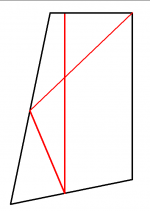
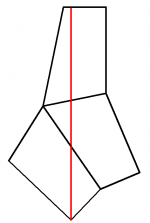
.jpg)
